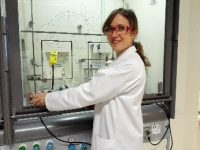On June 21st, Martina Orefice (SOLVOMET Group, SIM² KU Leuven & Early Stage Researcher in the ETN DEMETER project) obtained her PhD degree in Chemistry. She successfully defended her PhD thesis entitled “Solvometallurgical recovery of metal values from Sm‒Co and Nd‒Fe‒B permanent magnets”. (Leuven, 24/07/2019)
Martina Orefice carried out her PhD in the SOLVOMET group of Prof. Dr. Koen Binnemans, her supervisor. Dr. Tom Vander Hoogerstraete was her co-supervisor. The PhD project was part of the H2020-MSCA-ETN DEMETER project, for the design and recycling of rare-earth permanent magnet motors and generators in hybrid and full electric vehicles. Dr. Orefice will continue her career in the SOLVOMET group, as postdoc researcher for the recovery of tungsten, niobium and tantalum in the framework of the H2020 TARANTULA project.
The abstract of the PhD thesis and a list of the works published in peer-reviewed journals are available below, the full text of the thesis will be made public after the last results will also be published in peer-reviewed journals.
Abstract
Two main features of (hybrid) electric vehicles are sensitive to a sustainable end-of-life treatment: the battery and the traction motor. Compared to the large extent of research about battery recycling, studies on the sustainability of electric traction motors had so far a marginal attention. However, the most efficient and convenient of these motors rely on rare-earth permanent magnets and are, together with wind turbines, the main cause of depletion of the critical rare-earth elements. Recycling of end-of-life permanent magnets from electric motors will be a valid support to keep the production and demand of rare earths in balance. Furthermore, rare-earth permanent magnets are also an interesting secondary source of cobalt, primarily extracted in a critical geopolitical context.
This PhD thesis explores innovative recycling routes of Sm‒Co and Nd‒Fe‒B permanent magnets, based on solvometallurgy, which is an emerging branch of extractive metallurgy. Although the concept of solvometallurgy itself is not new, there exist only few examples of solvometallurgy applied to urban mining. Since most electric motors contain sintered Nd‒Fe‒B permanent magnets, research in this PhD thesis was mainly focused on this type of magnets.
First of all, the microstructure of Nd‒Fe‒B permanent magnets was investigated. Microscopy and image analysis revealed a reactivity order of the three phases of the Nd‒Fe‒B permanent magnets different from what reported in the literature. An ionic liquid comprising a concentrated strong acid was used as etchant. Afterwards, a leaching process based solely on water-free ionic liquids revealed limits of solvometallurgy when water is removed from the system. Possible causes and solutions have been investigated in detail and it was found out that the leaching efficiency was also effected by the formation in the roasting preliminary step of the ternary oxide NdFeO3 instead of the expected binary oxide Nd2O3.
Controlling the roasting atmosphere allowed to obtain the desired Nd2O3 phase and the leaching yields were increased. In this way, a combined pyrometallurgical‒solvometallurgical recycling route was developed. Finally, two flowsheets were designed, with the aim to use solely solvometallurgical process steps, one flowsheet for the recycling of Sm‒Co magnets and another one for the recycling of Nd‒Fe‒B magnets.
Another limit of solvometallurgy became evident: precipitation of the metals of interest did not occur in the solvent used. However, a step of precipitative stripping helped to save one operation unit and to mitigate the disadvantage. Solvometallurgy, in fact, resulted in improved leaching and solvent-extraction processes: the processing time can be reduced, the temperature can be increased above 100 °C, without the need of using an autoclave, and differences in solvation of the ions occur, affecting the equilibria in solution.
In conclusion, solvometallurgy can be a valid technology for the recycling of rare-earth permanent magnets, but the replacement of the aqueous phase in hydrometallurgy by an organic phase in solvometallurgy is not trivial. In particular, attention needs to be paid to the choice of the solvents and to the way of recovering the metals from the solvent phases.
List of publications
- Orefice, M., Eldosouky, A., Škulj I., Binnemans, B. 2019, “Removal of metallic coatings from rare-earth permanent magnets by solutions of bromine in organic solvents”, RSC Advances 9 (26), 14910–14915. doi:10.1039/C9RA01696A
- Orefice, M., Audoor, H., Li, Z. & Binnemans, K. 2019, "Solvometallurgical route for the recovery of Sm, Co, Cu and Fe from SmCo permanent magnets", Separation and Purification Technology, 219, 281-289, doi:10.1016/j.seppur.2019.03.029
- Li, X., Li, Z., Orefice, M. & Binnemans, K. 2019, "Metal recovery from spent samarium-cobalt magnets using a trichloride ionic liquid", ACS Sustainable Chemistry and Engineering, 7 (2), 2578-2584, doi:10.1021/acssuschemeng.8b05604
- Orefice, M., Binnemans, K. & Vander Hoogerstraete, T. 2018, "Metal coordination in the high-temperature leaching of roasted NdFeB magnets with the ionic liquid betainium bis(trifluoromethylsulfonyl)imide", RSC Advances, 8 (17), 9299-9310, doi:10.1039/c8ra00198g
Manuscripts under preparation
- Orefice, M., Binnemans, K. "High-temperature solvent extraction from an ionic liquid leachate of Nd‒Fe‒B permanent magnets"
- Orefice, M., Van den Bulck, A., Blanpain, B., Binnemans, K. "Selective roasting of Nd‒Fe‒B permanent magnets as a pre-treatment step for intensified leaching with an ionic liquid"
- Bailey, G., Sprecher, B., Onal, M. A. R., Orefice, M., Herraiz, E., Dewulf, W., Van Acker, K. "Comparative Life Cycle Assessment of the Production of Rare Earth Permanent Magnets SmCo5 and Nd‒Fe‒B"

 SOLCRIMET Advanced ERC Grant
SOLCRIMET Advanced ERC Grant